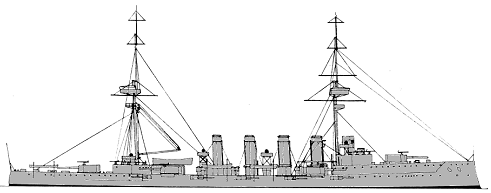
NAVYPEDIA
 Support the project with paypal
Support the project with paypal
Photo

Duke of Edinburgh 1900s
Ships
| Name | No | Yard No | Builder | Laid down | Launched | Comp | Fate |
|---|---|---|---|---|---|---|---|
| Duke of Edinburgh | 15, 58, N33 | 238 | Pembroke DYd | 11.2.1903 | 14.6.1904 | 20.1.1906 | sold 4.1920 |
| Black Prince | 65 | Thames Iron Wks, Blackwall | 3.6.1903 | 8.11.1904 | 17.3.1906 | sunk 31.5.1916 |
Technical data
| Displacement normal, t | 13550 |
|---|---|
| Displacement full, t |
|
| Length, m | 146.3 pp 154.1 oa |
| Breadth, m | 22.4 |
| Draught, m | 7.92 |
| No of shafts | 2 |
| Machinery | 2 4-cyl VTE, 20 Babcock and 6 cylindrical boilers |
| Power, h. p. | 23000 |
| Max speed, kts | 23 |
| Fuel, t | coal 2150 |
| Endurance, nm(kts) | 5800(14) |
| Armour, mm | belt: 152 - 76, bulkheads: 51, decks: 38 - 19, turrets: 190 - 114, barbettes: 152, battery: 152, ammunition tubes: 76, CT: 254 |
| Armament | 6 x 1 - 234/47 BL Mk X, 10 x 1 - 152/50 BL Mk XI, 22 x 1 - 47/50 3pdr Vickers Mk I, 3 - 450 TT (sub, 1 bow, 2 beam) |
| Complement | 790 |
Standard scale images

Black Prince 1914
Graphics
Project history
Provided under the 1902/03 Programme, these ships were the first RN vessels to be designed under the direction of Phillip Watts and showed a substantial change in style over earlier types. In addition, attempts to restrict the size of first class cruisers was finally abandoned and displacement increased to allow for improvements in armament, protection and machinery power. The 234mm gun was re-adopted and fitted in single turrets arranged similarly to those in the Devonshire class except that wing positions were provided abreast the mainmast as well as the foremast. As in the King Edward VII class battleships the 152mm gun casemate protection of earlier ships was abandoned in favour of a central armoured battery on the main deck with ports for five guns on each side; the aftermost ports were embrasured, to allow astern fire, but not those forward, presumably to avoid spray problems. Unfortunately the 152mm guns were so close to the waterline that they were unworkable in anything but very calm weather. The reduction of shell-bursting structures reached its final stage in these ships which had clear upper decks without the traditional high bulwarks, but this, combined with a low freeboard, resulted in their being wet amidships although the high forecastle allowed them to maintain a high speed in a seaway. The 47mm guns were virtually useless as anti-torpedo weapons and their adoption in this and the following class is inexplicable. Eight were mounted on the forward and after superstructures and one on each 234mm turret. Despite the apparent improvements over earlier classes the ineffective secondary battery reduced the value of these ships considerably and they did not enjoy a high reputation.
Ship protection
They had a full length waterline belt which was 152mm thick over 79.3m amidships reducing to 102mm forward and 76mm aft. The central battery had 152mm sides and bulkheads and effectively increased the height of the side armour amidships to the level of the upper deck. The engine room hatch between the lower and main decks was protected by 51mm plating and 51mm screens were provided between the 152mm guns in the battery. The wing barbettes reduced to 76mm behind the battery armour and the turrets had 190mm faces, 140mm sides and 114mm backs. Deck protection was very weak with a 19mm lower deck increasing to 38mm over the steering gear, a 25mm main deck reducing to 19mm under the central battery, and a 25mm upper deck over the battery.
Modernizations 3.
1916, both: - 10 x 1 - 152/50; + 6 x 1 - 152/50 BL Mk XI (in shields between the main deck 234mm turrets).
5/1917, Duke of Edinburgh: - 14 x 1 - 47/50; + 2 x 1 - 152/50 BL Mk XI (in embrasures on the forecastle deck), 1 x 1 - 76/45 20cwt QF Mk I, foremast became tripod.
Naval service
Black Prince was sunk by gunfire from German battleships during the night action at Jutland 31.5.1916, all hands lost.
Many thanks to Wolfgang Stöhr for additional information on this page.
 HOME
HOME FIGHTING SHIPS OF THE WORLD
FIGHTING SHIPS OF THE WORLD UNITED KINGDOM
UNITED KINGDOM CRUISERS
CRUISERS DUKE OF EDINBURGH 1 class armoured cruisers (2, 1906)
DUKE OF EDINBURGH 1 class armoured cruisers (2, 1906)
